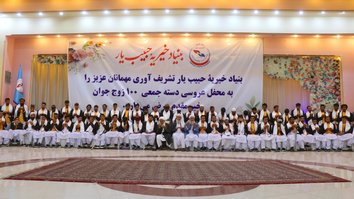KANDAHAR -- Blasts tore through the Shia Fatemiyyeh mosque in Kandahar city on Friday (October 15), killing at least 33 people and injuring 74 others.
The explosions came a week after a suicide attack on Shia worshippers at a mosque in Kunduz city that was claimed by the Khorasan branch of the "Islamic State of Iraq and Syria" (ISIS-K). The Kunduz suicide bombing killed about 100 Afghans.
A doctor at the city's central Mirwais hospital told AFP: "Thirty-three bodies and 74 wounded people have been brought to our hospital so far."
Other medical sources and a provincial official confirmed a toll of more than 30, and at least 15 ambulances were rushing to and from the scene.
"We are overwhelmed," the doctor told AFP.
"There are too many dead bodies and wounded people brought to our hospital. We are expecting more to come. We are in urgent need of blood. We have asked all the local media in Kandahar to ask people to come and donate blood."
An eyewitness told AFP he heard three explosions, one at the main door of the mosque, another in a southern area, and a third where worshippers wash and prepare for prayer.
Another witness also said that three blasts rocked the mosque in the centre of the town during Friday prayers -- the busiest congregation of the week.
"We are saddened to learn that an explosion took place in a mosque of the Shia brotherhood in the first district of Kandahar city in which a number of our compatriots were martyred and wounded," tweeted Qari Sayed Khosti, a spokesman for the Taliban's Interior Ministry.
"Special forces of the Islamic Emirate have arrived in the area to determine the nature of the incident and bring the perpetrators to justice."
Graphic images posted to social media, which could not be immediately verified, showed bodies lying on the floor of the Fatemiyyeh mosque.
ISIS-K threat
The latest slaughter comes after an ISIS-K suicide bomber targeted a Shia mosque in Kunduz on October 8, killing scores of people.
The group, a bitter rival of the Taliban, claimed responsibility for the attacks on Shia worshippers, whom it regards as heretics.
The Taliban themselves have a history of persecuting Shias, and a spree of prison breaks by the Taliban during their summer offensive freed many ISIS militants.
UK-based conflict analysis firm ExTrac said that if claimed by ISIS-K, Friday's attack would be the first by the group in Kandahar, and the fourth mass casualty massacre since the Taliban took Kabul.
While Taliban spokesman Zabiullah Mujahid has downplayed the ISIS threat, commanders on the ground do not dismiss it so lightly.
Two members of the movement's intelligence services told Reuters in September that investigations of recent attacks in Jalalabad, Nangarhar province, have shown that ISIS-K remains a danger, even if it does not have enough fighters or resources to seize territory.
In addition to mosque attacks, ISIS-K militants have been using the same tact that the Taliban have used to target government officials and civil society figures: magnetic bombs usually stuck to the underside of cars, also known as sticky bombs.
But now these attacks are targeting the Taliban themselves.
"We are worried about these sticky bombs that once we used to apply to target our enemies in Kabul," one of the Taliban intelligence officials told Reuters. "We are concerned about our leadership as they could target them if not controlled them [sic] successfully."
The latest estimates of ISIS-K's strength vary from 500 active fighters to as high as several thousand, according to a United Nations report in July.

![Afghan men inspect the damage inside a Shia mosque in Kandahar on October 15 after a suicide bombing during Friday prayers that killed at least 32 people. [Javed Tanveer/AFP]](/cnmi_st/images/2021/10/15/32135-000_9pq8mt-585_329.jpg)







How cheap do they think the blood of humans is!? What kind of Muslim would it be who kills his Muslim brother in the mosque? This is a project that is created by the infidels. They showed Muslims as terrorists and introduced Muslims as terrorists. This is the work of someone who today presents himself as the superpower of the world. It is not an easy task for a few people to make an organization called ISIS and start terror in most of the Islamic countries, and in a few months or days, gain enough fame that all the people of the world fear their name. Anyone who makes an organization under a name must have sufficient funds. Such organizations cannot be established for one hundred thousand dollars or one million dollars and without support of any country. These organizations have the financial support of a country or other. You see, no Islamic country sells arms to another country, but Islamic countries also buy arms from non-Islamic countries. All the wars that are going on in Islamic countries, is not the work of Muslims, it is the work of non-Islamic countries who have made Muslims fight. Every country that produces weapons and sells them to other countries, responsibility of all these wars that are going on in the world goes to the same country that sells weapons to other countries.
Reply1 Comment